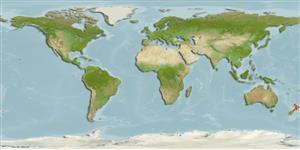Environment: milieu / climate zone / depth range / distribution range
Ökologie
seewasser riff-verbunden; tiefenbereich 4 - 110 m (Ref. 13227), usually 4 - 20 m (Ref. 13227). Temperate
Southwest Pacific: New Zealand.
Size / Gewicht / Alter
Maturity: Lm ? range ? - ? cm
Max length : 5.0 cm SL Männchen/unbestimmt; (Ref. 13227)
Kurzbeschreibung
Morphologie | Morphometrie
Rückenflossenstacheln (insgesamt): 23 - 27; Rückenflossenweichstrahlen (insgesamt): 12-15; Afterflossenstacheln 2; Afterflossenweichstrahlen: 25 - 30; Wirbelzahl: 39 - 46. Short denticles present on inter-radial circuli. Pterygiophore supporting first segmented ray of third dorsal fin anterior to neural spine of 25th vertebra. Dorsal fin formula V-0N-0-1-0-
1. Nine procurrent rays in upper caudal lobe, 8 in lower lobe; in upper lobe 1 ray between upper lobe and posterior epural, 5 rays opposite epurals, 3 rays anterior to anterior epural; in lower lobe, 1 ray between lower lobe and haemal spine of second preural vertebra, 6 rays opposite haemal spine of third preural vertebra, 1 ray anterior to haemal spine of third preural vertebra. Front of body white with black eyes, black stripe extending to below base of second dorsal fin, rear part of body white or yellow; body yellow with black head in breeding males, females and non-breeding males white anteriorly, white or yellow posteriorly, with black stripe along lateral line, only reaching to mid-body (Ref. 84085).
Facultative air-breathing in the genus (Ref. 126274); Adults usually inhabit rocky reefs (Ref. 84085). They are found on the sides or under overhangs of large boulders, sheltering in the massive sponge growths or in large, deep crevices. They feed mainly on amphipods, and also on barnacle cyprids and polychaete larvae. Males maybe territorial during the breeding season (Ref. 13227). Eggs are hemispherical and covered with numerous sticky threads that anchor them in the algae on the nesting sites (Ref. 240). Larvae are planktonic which occur primarily in shallow, nearshore waters (Ref. 94114).
Life cycle and mating behavior
Geschlechtsreife | Fortpflanzung | Ablaichen | Eier | Fecundity | Larven
Fricke, R., 1994. Tripterygiid fishes of Australia, New Zealand and the southwest Pacific Ocean (Teleostei). Theses Zool. 24:1-585. (Ref. 13227)
IUCN Rote Liste Status (Ref. 130435)
Bedrohung für Menschen
Harmless
Nutzung durch Menschen
Fischereien: nicht kommerziell
Mehr Information
NamenSynonymeMetabolismusRäuberÖkotoxikologieFortpflanzungGeschlechtsreifeAblaichenSpawning aggregationFecundityEierEientwicklung
Alter/GrößeWachstumLänge-GewichtLänge-LängeLängenhäufigkeitenMorphometrieMorphologieLarvenLarven Pop.Dyn.RekrutierungDichteBRUVS
ReferenzenAquakulturAquakultur ProfilZuchtlinienGenetikElectrophoresesVererbbarkeitKrankheitenVerarbeitungNutrientsMass conversion
PartnerBilderStamps, Coins Misc.LauteCiguateraGeschwindigkeitSchwimmstilKiemenoberflächeOtolithsGehirngrößeSehfähigkeit
Tools
Zusatzinformationen
Download XML
Internet Quellen
Estimates based on models
Preferred temperature (Ref.
123201): 13.5 - 22.4, mean 18.4 °C (based on 24 cells).
Phylogenetic diversity index (Ref.
82804): PD
50 = 0.5039 [Uniqueness, from 0.5 = low to 2.0 = high].
Bayesian length-weight: a=0.00562 (0.00258 - 0.01228), b=3.08 (2.89 - 3.27), in cm total length, based on LWR estimates for this (Sub)family-body shape (Ref.
93245).
Trophic level (Ref.
69278): 3.3 ±0.44 se; based on food items.
Widerstandsfähigkeit (Ref.
120179): hoch, Verdopplung der Population dauert weniger als 15 Monate. (Preliminary K or Fecundity.).
Fishing Vulnerability (Ref.
59153): Low vulnerability (10 of 100).
Nutrients (Ref.
124155): Calcium = 97.8 [37.9, 286.6] mg/100g; Iron = 0.57 [0.21, 1.26] mg/100g; Protein = 18.4 [16.8, 20.0] %; Omega3 = 0.314 [0.101, 0.983] g/100g; Selenium = 13.5 [3.7, 47.1] μg/100g; VitaminA = 41.2 [6.0, 250.7] μg/100g; Zinc = 1.76 [0.89, 3.24] mg/100g (wet weight);
